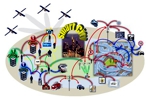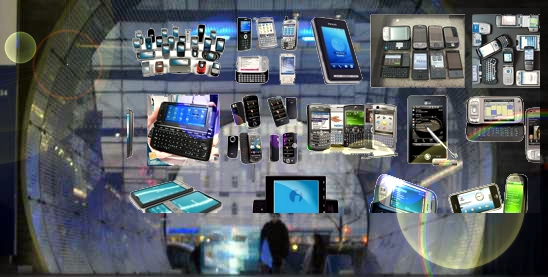
 Scientists of the TU Darmstadt are working on the Smart City. Smart phones, equipped with numerous sensors, significantly simplify for their owners the organization of several aspects of their lives. But this is only the beginning; scientists of Darmstadt envision an entire smart city in which all sensor-equipped devices are interlinked in an intelligent manner.
Scientists of the TU Darmstadt are working on the Smart City. Smart phones, equipped with numerous sensors, significantly simplify for their owners the organization of several aspects of their lives. But this is only the beginning; scientists of Darmstadt envision an entire smart city in which all sensor-equipped devices are interlinked in an intelligent manner.
In order to realize this vision, computer scientists, electrical and information engineers, as well as mathematicians of the TU Darmstadt and the University Kassel are working together on the research priority program “Cocoon”.
 The basis of a smart city is a (communication) network of sensors gathering, analyzing and redirecting data or signals.
The basis of a smart city is a (communication) network of sensors gathering, analyzing and redirecting data or signals.
Each sensor acts as transmitter and receiver simultaneously, so- called transceiver.
This form of networked communication operates wirelessly over radio and provides additional value for participants: In the already purchasable control system Smart Home – for example – all technical devices are interconnected and automatically controlled according to their respective requirements. The energy saving potential should reach 15 per cent.
The Smart Hospital, Smart Industry or Smart Farm could shortly follow the Smart Home. And even smart systems specific to mobile networks are possible: Traffic jams could be avoided by car-to-car or car-to-x communication.
Also the health care system could profit from mobile sensor communication if patients are everywhere supplied with information matched to their health needs. Sensors attached to the body could also measure their health condition and issue an emergency call whenever necessary.
Smart and Mobile Thanks to Beamforming
The greatest hurdle in a smart city according to the scientists is the fact that sensors are in constant
mobility. In mobile smart systems, sensors continuously vary their position, new ones join the
network, and others leave.
The sensor-equipped devices should take this fact into account by reacting sensitively to the environment and ensuring efficient reception and transmission. Here beamforming should help in radiation control. “Standard antennas radiate in all directions like a light bulb,” clarify scientists of Cocoon.
“We would like to create the conditions whereby antennas in future function like spotlights. One can imagine this to be like in a disco: When a spotlight locates the sought-for person, it focuses the beam on him, and can follow him through the room and at the same time fade other people out.
Antennas can, through communication transmission, focus on the desired device, follow it and at the same time fade out the interference caused by electromagnetic waves of the other devices in the vicinity.”
Such antennas, or the transceivers equipped therewith, are also reconfigurable; that is to say
they can be variably set according to environmental conditions – by circuit or remote-control. In
cooperation with an industrial partner, Cocoon scientists have already equipped DVBT transmitters
with reconfigurable amplifiers which allow the transmit signal to be amplified up to ten per cent. “If
all DVBT units in Germany were equipped with such amplifiers, we could shut down a nuclear power
plant.”
Frequencies Are a Scarce Resource
Reconfigurable devices have another advantage, however: They make substantially more efficient
use of the tightly restricted frequency resources. So far, fixed frequency ranges are assigned, where
the user density in heavily occupied frequency bands lies merely between 15 and 20 per cent. Thanks
to beamforming, the available frequencies can be utilized considerably more efficiently.
Small Model Networks in Sight
Yet another fundamental problem should be solved before the smart city can becomes reality: Sensor communication requires the cooperation of all devices over all communication technologies, such as Bluetooth, and over all networks, such as the European mobile radio network Global System for Mobile Communication (GSM) or the local radio network Wireless Local Area Network (WLAN) as well. This is not feasible with current networks, devices and communication technologies.
“It will not be possible to convert all devices operating on a certain communication technology, a so-called protocol. We are therefore looking for a new technology that virtually overlays all others and allows communication among the different protocols,” clarify Cocoon scientists. In the end, data transfer should also sustain an immense flood of information – “For a Smart City Darmstadt alone, with satellites, cellphones, computers and all other already available devices, certainly a million sensors would communicate amongst themselves,” says the coordinator of Cocoon, Prof. Abdelhak Zoubir, from the Department of Electrical Engineering and Information Technology of the TU Darmstadt.
And since a single mobile sensor can in one year easily generate hundreds of Megabytes of information, new models are necessary, where data is more densely compressed, in order to guarantee error-free communication. Until the smart city becomes reality, some obstacles have yet to be overcome. Nevertheless, the scientists of Cocoon are optimistic that within three years, they will be able to simulate small preliminary model networks of a smart city with different devices.
Research Support by the State of Hesse
For their research within the framework of the focal point “Cocoon – Cooperative Sensor Communication”, scientists of the TU Darmstadt are to receive 4.5 million euros over the coming three years through the Landes-Offensive zur Entwicklung wissenschaftlich-ökonomischer Exzellenz (LOEWE) des Landes Hessen.
————————————————————-
Dr.-Ing. Dietmar Hildenbrand – Geschäftsführer / General Manager LOEWE Forschungsschwerpunkt Cocoon, Technische Universität Darmstadt
For more information: http://www.cocoon.tu-darmstadt